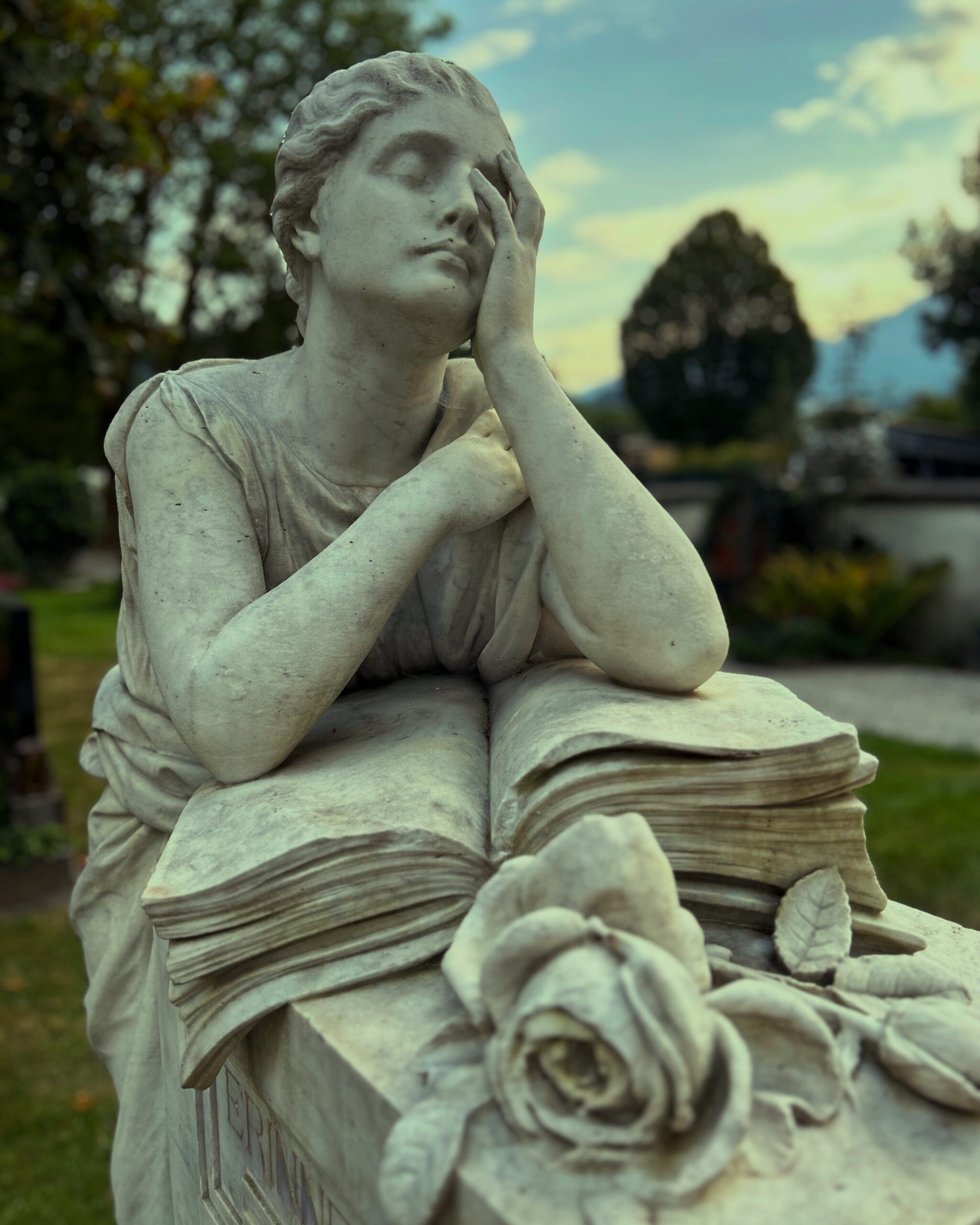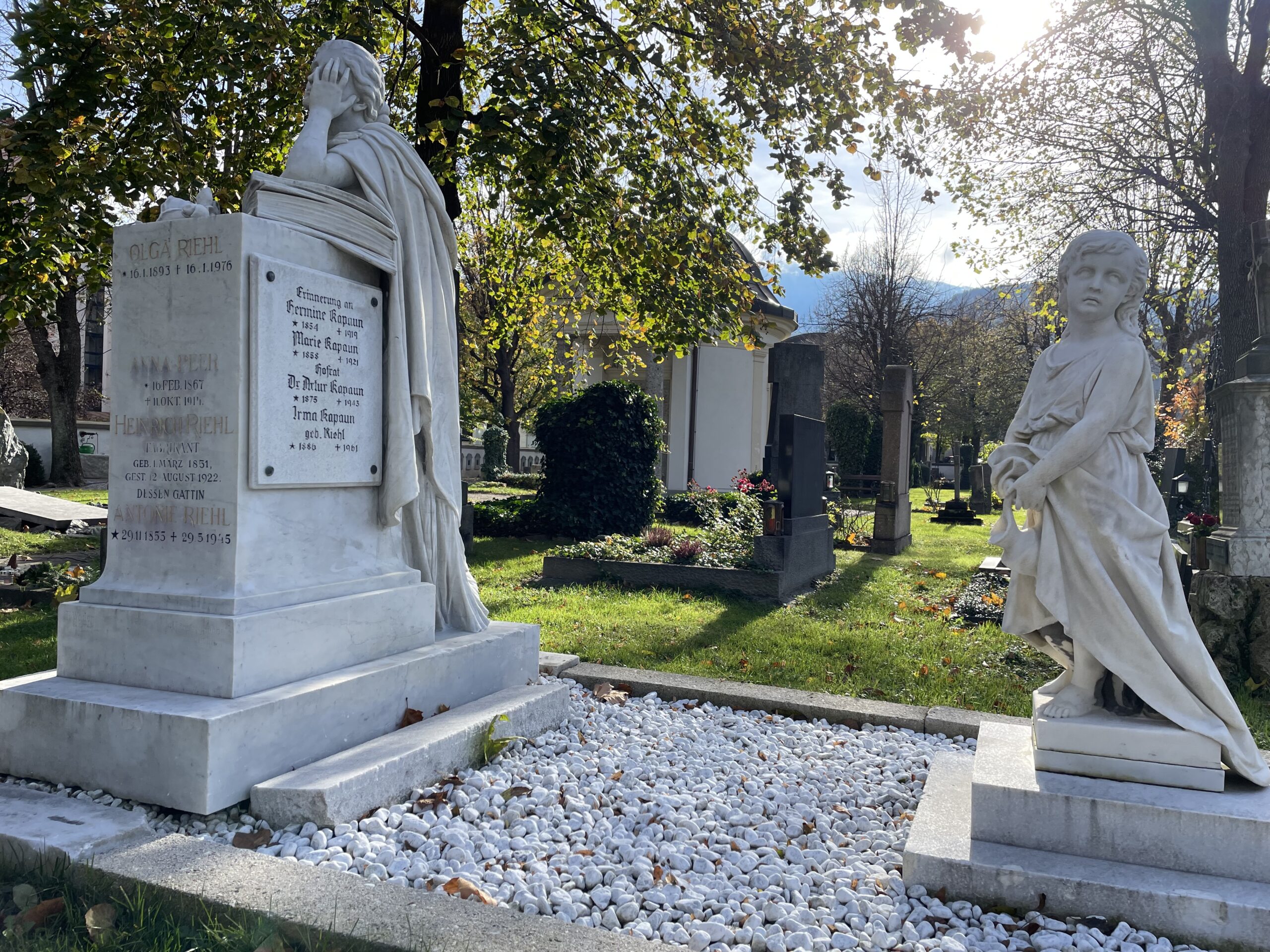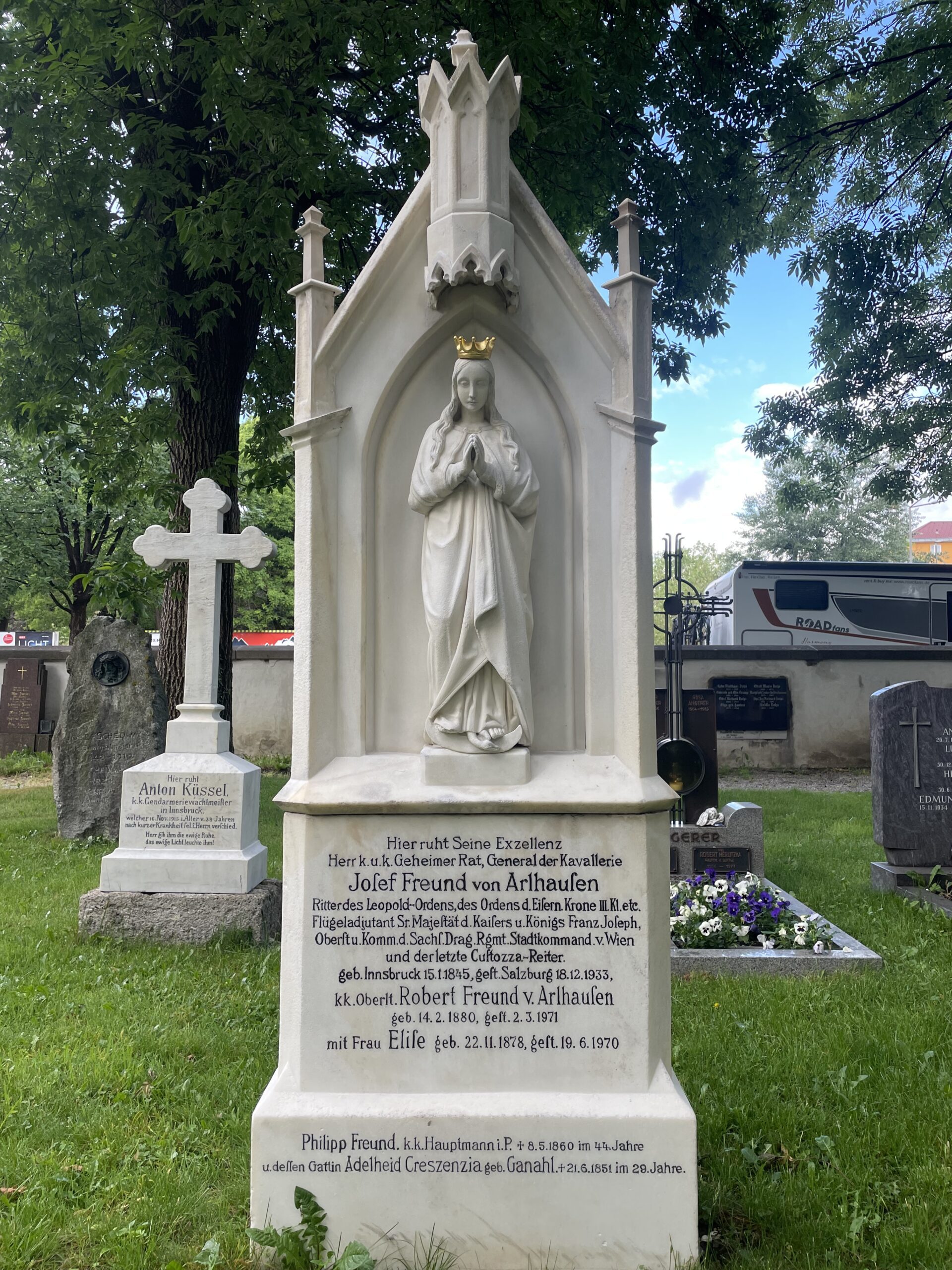Alter Militärfriedhof Pradl
Anzengruberstraße
Worth knowing
The k.u.k. military cemetery in Pradl is located in the centre of a quiet residential area between Anzengruberstraße and Resselstraße, directly opposite the Tivoli outdoor swimming pool. As has always been customary, this cemetery was also relocated to the outskirts of the town. The open space between Pradl and Amras was ideal for this purpose. The cemetery was dug in 1831 at the behest of the Imperial War Council, the predecessor organisation of the k.u.k. Ministry of War. The wall around the cemetery was built in 1844, after previously only a rampart had protected the graves. The chapel was also built in this year. During the 1st World War, the k.u.k. Military Cemetery became too small for the number of victims, which is why the military cemetery in Amras was rebuilt. The cemetery has been owned by the Republic of Austria since 1918. In 1933, the site was placed under a preservation order.
The preserved gravestones date back a long way and give an idea of the importance of the military in days gone by. A look at the list of armed conflicts that took place between the founding of the Austrian Empire in 1806 and the First World War shows that peace was only a brief interruption to the state of war. The retitling of the Court War Council The change in the term Ministry of Defence today shows how much the ideas surrounding this topic have fortunately changed since the two world wars.
However, the military was more than just war machinery. Since the 18th century, the army had become a social factor. The ever-growing armies needed more personnel than ever before. Military service opened up career opportunities for subjects. The reputation and importance of soldiers and officers among the population was very different to today, where military service is perceived by the majority of people as a chore. Fulfilling one's patriotic duty in the field was considered an honourable duty, especially among the minor nobility and the upper middle classes. Young lads from rural areas, who fell through the cracks as a result of the law of inheritance, which stipulated that farm estates should be passed on undivided, were able to make a career and gain prestige within society. In the 19th century, it was possible to fight your way into the lower nobility on the battlefields. Anyone taking a walk through the old Pradler military cemetery will not only discover artistically designed graves, but also formulations that have changed over time for the long romanticised "Heldentod“ für Gott, Kaiser und Vaterland.
Two well-known Innsbruck citizens to whom a street name was dedicated are buried at the Pradl military cemetery. The rebellious poet Johann Chrysostomus Senn, who was posthumously honoured for his poem The red Tyrolean eagle He was buried here as a former k.k. military officer was buried here. The visionary builder and entrepreneur Josef Riehl, who financed and built two pioneering infrastructure projects of the late imperial and royal era with the Hungerburgbahn and the Karwendelbahn. His final resting place is in the remarkable family grave, complete with an elaborate sculpture of a woman and a girl.
1796 - 1866: Vom Herzen Jesu bis Königgrätz
The period between the French Revolution and the Battle of Königgrätz in 1866 was a period of war. The monarchies of Europe, led by the Habsburgs, had declared war on the French Republic. Fears were rife that the motto of the Revolution "Liberté, Égalité, Fraternité" could spread across Europe. A young general named Napoleon Bonaparte was with his italienischen Armee advanced across the Alps as part of the coalition wars and met the Austrian troops there. It was not just a war for territory and power, it was a battle of systems. The Grande Armee of the revolutionary French Republic met the arch-Catholic Habsburgs.
Tyrolean riflemen were involved in the fighting to defend the country's borders against the invading French. Companies such as the Höttinger Schützen, founded in 1796, faced the most advanced and best army in the world at the time. The Cult of the Sacred Heart, which still enjoys great popularity in Tyrol today, dates back to this time. In a hopeless situation, the Tyrolean troops renewed their covenant with the heart of Jesus to ask for protection. It was the abbot of Stams Monastery who petitioned the provincial estates to henceforth organise an annual "das Fest des göttlichen Herzens Jesu mit feierlichem Gottesdienst zu begehen, wenn Tirol von der drohenden Feindesgefahr befreit werde." Every year, the Sacred Heart celebrations were discussed and announced with great pomp in the press. Particularly in the 19th and early 20th centuries, they were an explosive mixture of popular superstition, Catholicism and national resentment against everything French and Italian. Alongside Cranach's Mother of Mercy, the depiction of the heart of Jesus is probably the most popular Christian motif in the Tyrolean region to this day and is emblazoned on the façades of countless houses.
In the war years of 1848, 1859 and 1866, the so-called Italian wars of unification. In the course of the 19th century, at the latest since 1848, there was a veritable national frenzy among young men. Volunteer armies sprang up in all regions of Europe. Students and academics who came together in their associations, gymnasts, marksmen, all wanted to prove their new love of the nation on the battlefield and supported the official armies. Probably the most famous battle of the Wars of unification took place in Solferino near Lake Garda in 1859. Horrified by the bloody events, Henry Durant decided to found the Red Cross. The writer Joseph Roth described the events in the first pages of his classic book, which is well worth reading Radetzkymarsch.
"In the battle of Solferino, he (note: Lieutenant Trotta) commanded a platoon as an infantry lieutenant. The battle had been going on for half an hour. Three paces in front of him he saw the white backs of his soldiers. The first row of his platoon was kneeling, the second was standing. Everyone was cheerful and certain of victory. They had eaten copiously and drunk brandy at the expense and in honour of the emperor, who had been in the field since yesterday. Here and there one fell out of line."
As a garrison town, Innsbruck was an important supply centre. After the Congress of Vienna, the Tyrolean Jägerkorps the k.k. Tiroler Kaiserjägerregiment an elite unit that was deployed in these conflicts. Volunteer units such as the Innsbruck academics or the Stubai Riflemen were fighting in Italy. The media fuelled the atmosphere away from the front line. The "Innsbrucker Zeitung" predigte in ihren Artikeln Kaisertreue und großdeutsch-tirolischen Nationalismus, wetterte gegen das Italienertum und Franzosen und pries den Mut Tiroler Soldaten.
"Die starke Besetzung der Höhen am Ausgange des Valsugana bei Primolano und le Tezze gab schon oft den Innsbrucker-Akademikern I. und den Stubaiern Anlaß, freiwillige Ercur:sionen gegen le Tezze, Fonzago und Fastro, als auch auf das rechte Brenta-Ufer und den Höhen gegen die kleinen Lager von den Sette comuni zu machen...Am 19. schon haben die Stubaier einige Feinde niedergestreckt, als sie sich das erste mal hinunterwagten, indem sie sich ihnen entgegenschlichen..."
The year 1866 was particularly costly for the Austrian Empire, with the loss of Veneto and Lombardy in Italy. At the same time, Prussia took the lead in the German Confederation, the successor organisation to the Holy Roman Empire of the German Nation. For Innsbruck, the withdrawal of the Habsburg Monarchy from the German Confederation meant that it had finally become a city on the western periphery of the empire. The tendency towards so-called Großdeutschen LösungThe German question, i.e. statehood together with the German Empire instead of the independent Austrian Empire, was more pronounced in Innsbruck than in the rest of the country. The extent to which this German question divided the city became apparent over 30 years later, when the Innsbruck municipal council voted in favour of the Iron Chancellor Bismarck, who was responsible for the fratricidal war between Austria and Germany, wanted to dedicate a street to him. While conservatives loyal to the emperor were horrified by this proposal, the Greater German liberals around Mayor Wilhelm Greil were delighted by this gesture of unification.
However, the national aspirations of the individual ethnic groups did not stop at Tyrol in an idealistic sense, as the Trentino region between Salurn and Riva on Lake Garda also included an Italian-speaking part of the country. In the Tyrolean state parliament, Italian-speaking members of parliament called for so-called Irredentistsmore rights and autonomy for what was then South Tyrol. In Innsbruck, there were repeated tensions and clashes between Italian and German-speaking students. The WallschenThis term for Italians persists to this day and they were considered dishonourable, unreliable and lazy.
With the Tummelplatz, the Pradl military cemetery and the Kaiserjägermuseum on Mount Isel, Innsbruck has several places of remembrance of this time of great loss for the Habsburgs.
The First World War and the Italian occupation
It was almost not Gavrilo Princip, but a student from Innsbruck who changed the fate of the world. It was thanks to chance that the 20-year-old Serb was stopped in 1913 because he bragged to a waitress that he was planning to assassinate the heir to the throne. It was only when the world-changing shooting in Sarajevo actually took place that an article about it appeared in the media. After the actual assassination of Franz Ferdinand on 28 June, it was impossible to foresee what impact the First World War that broke out as a result would have on the world and people's everyday lives. However, two days after the assassination of the Habsburg in Sarajevo, the Innsbrucker Nachrichten already prophetic: "We have reached a turning point - perhaps the "turning point" - in the fortunes of this empire".
Enthusiasm for the war in 1914 was also high in Innsbruck. From the "Gott, Kaiser und VaterlandDriven by the "spirit of the times", most people unanimously welcomed the attack on Serbia. Politicians, the clergy and the press joined in the general rejoicing. In addition to the imperial appeal "To my peoples", which appeared in all the media of the empire, the Innsbrucker Nachrichten On 29 July, the day after Austria-Hungary declared war on Serbia, the media published an article about the capture of Belgrade by Prince Eugene in 1717. The tone in the media was celebratory, although not entirely without foreboding of what was to come.
"The Emperor's appeal to his people will be deeply felt. The internal strife has been silenced and the speculations of our enemies about unrest and similar things have been miserably put to shame. Above all, the Germans stand by the Emperor and the Empire in their old and well-tried loyalty: this time, too, they are ready to stand up for dynasty and fatherland with their blood. We are facing difficult days; no one can even guess what fate will bring us, what it will bring to Europe, what it will bring to the world. We can only trust with our old Emperor in our strength and in God and cherish the confidence that, if we find unity and stick together, we must be granted victory, for we did not want war and our cause is that of justice!"
Theologians such as Joseph Seeber (1856 - 1919) and Anton Müllner alias Bruder Willram (1870 - 1919) who, with her sermons and writings such as "Das blutige Jahr" elevated the war to a crusade against France and Italy.
Many Innsbruckers volunteered for the campaign against Serbia, which was thought to be a matter of a few weeks or months. Such a large number of volunteers came from outside the city to join the military commissions that Innsbruck was almost bursting at the seams. Nobody could have guessed how different things would turn out. Even after the first battles in distant Galicia, it was clear that it would not be a matter of months.
In 1915, the Kingdom of Italy entered the war on the side of France and England. This meant that the front went right through what was then Tyrol. From the Ortler in the west across northern Lake Garda to the Sextener Dolomiten the battles of the mountain war took place. Innsbruck was not directly affected by the fighting. However, the war could at least be heard as far as the provincial capital, as was reported in the newspaper of 7 July 1915:
„Bald nach Beginn der Feindseligkeiten der Italiener konnte man in der Gegend der Serlesspitze deutlich Kanonendonner wahrnehmen, der von einem der Kampfplätze im Süden Tirols kam, wahrscheinlich von der Vielgereuter Hochebene. In den letzten Tagen ist nun in Innsbruck selbst und im Nordosten der Stadt unzweifelhaft der Schall von Geschützdonner festgestellt worden, einzelne starke Schläge, die dumpf, nicht rollend und tönend über den Brenner herüberklangen. Eine Täuschung ist ausgeschlossen. In Innsbruck selbst ist der Donner der Kanonen schwerer festzustellen, weil hier der Lärm zu groß ist, es wurde aber doch einmal abends ungefähr um 9 Uhr, als einigermaßen Ruhe herrschte, dieser unzweifelhafte von unseren Mörsern herrührender Donner gehört.“
Until the transfer of regular troops from the eastern front to the Tyrolean borders, the national defence depended on the Standschützen, a troop consisting of men under 21, over 42 or unfit for regular military service.
The front was relatively far away from Innsbruck, but the war penetrated civilian life. This experience of the total involvement of society as a whole was new to the people. Barracks were erected in the Höttinger Au to house prisoners of war. Transports of wounded brought such a large number of horribly injured people that many civilian buildings such as the university library, which was currently under construction, or Ambras Castle were converted into military hospitals. The Pradl military cemetery was established to cope with the large number of fallen soldiers. A predecessor to tram line 3 was set up to transport the wounded from the railway station to the new garrison hospital, today's Conrad barracks in Pradl. The population in Innsbruck suffered from shortages, especially in the last winter, which was known as the Hunger winter went down in European history. In the final years of the war, food was supplied via ration coupons. 500 g of meat, 60 g of butter and 2 kg of potatoes were the basic diet per person - per week, mind you. Archive photos show the long queues of desperate and hungry people outside the food shops.
In October 1918, the first air raid alert was sounded, but no damage was done. At this time, most people were already aware that the war was lost and what fate awaited Tyrol, as this article from 6 October 1918 shows:
„Aeußere und innere Feinde würfeln heute um das Land Andreas Hofers. Der letzte Wurf ist noch grausamer; schändlicher ist noch nie ein freies Land geschachert worden. Das Blut unserer Väter, Söhne und Brüder ist umsonst geflossen, wenn dieser schändliche Plan Wirklichkeit werden soll. Der letzte Wurf ist noch nicht getan. Darum auf Tiroler, zum Tiroler Volkstag in Brixen am 13. Oktober 1918 (nächsten Sonntag). Deutscher Boden muß deutsch bleiben, Tiroler Boden muß tirolisch bleiben. Tiroler entscheidet selbst über Eure Zukunft!“
On 4 November, Austria-Hungary and the Kingdom of Italy finally agreed an armistice. This gave the Allies the right to occupy areas of the monarchy. The very next day, Bavarian troops entered Innsbruck. Austria's ally Germany was still at war with Italy and was afraid that the front could be moved closer to the German Reich in North Tyrol. Fortunately for Innsbruck and the surrounding area, however, Germany also surrendered a week later on 11 November. This meant that the major battles between regular armies did not take place.
Nevertheless, Innsbruck was in danger. Huge columns of military vehicles, trains full of soldiers and thousands of emaciated soldiers making their way home from the front on foot passed through the city. The city not only had to keep its own citizens in check and guarantee rations, but also protect itself from looting. In order to maintain public order, defence groups were formed from schoolchildren, students, workers and citizens. On 23 November 1918, Italian troops occupied the city and the surrounding area. Mayor Greil's appeasement to the people of Innsbruck to hand over the city without rioting was successful. Although there were isolated riots, hunger riots and looting, there were no armed clashes with the occupying troops or even a Bolshevik revolution as in Munich.
In Innsbruck, memorials to the First World War and the fallen are mainly found at churches and cemeteries. The Kaiserjägermuseum on Mount Isel displays uniforms, weapons and pictures of the battle. Streets in Innsbruck are dedicated to the two theologians Anton Müllner and Josef Seeber. A street was also named after the commander-in-chief of the Imperial and Royal Army on the Southern Front, Archduke Eugene. There is a memorial to the unsuccessful commander in front of the Hofgarten. The eastern part of the Amras military cemetery commemorates the Italian occupation.


